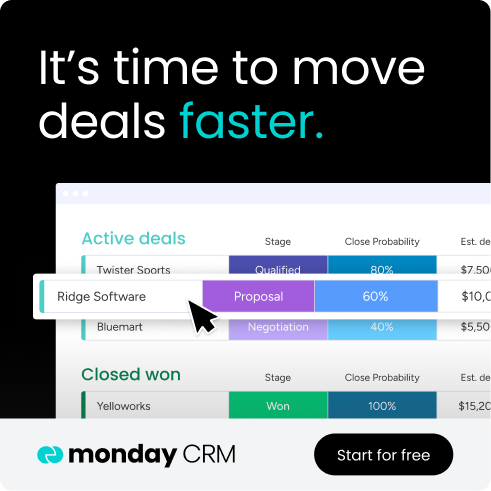Here’s the sales dilemma every revenue team knows: you need to keep filling the pipeline with solid opportunities, but your closers need to stay focused on winning deals. The answer lies in specialized roles that handle the time-intensive work of prospecting and qualification. Understanding what is SDR in sales becomes critical as organizations scale their revenue operations and need predictable pipeline generation.
An SDR (Sales Development Representative) serves as the engine of pipeline creation, identifying potential customers, making initial contact, and qualifying prospects before passing them to account executives. This specialization allows sales teams to operate more efficiently, with SDRs handling early-stage prospect development while account executives concentrate on advancing and closing deals.
Modern SDR teams leverage technology platforms to automate routine tasks, track multi-channel engagement, and maintain detailed prospect records that inform the entire sales process.
Let’s dig into what makes the SDR role tick – from day-to-day responsibilities and must-have skills to the tech stack they need and how AI is reshaping everything about the job. We’ll examine how SDRs fit within sales team structures, the technology that multiplies their productivity, and practical strategies for building effective SDR operations that drive consistent revenue growth.
Key takeaways
- SDRs are the pipeline engine: they qualify leads and book meetings so Account Executives (AEs) can focus on closing deals, not chasing cold prospects.
- Modern SDRs need multi-channel skills: success requires mastering email, phone, social media, and video outreach while using data to refine targeting strategies.
- AI transforms SDR productivity: A platform’s AI agent can call and qualify leads 24/7, automating initial outreach and booking meetings without complex setup.
- Clear role definitions drive Results: distinguish between SDRs (inbound qualification), BDRs (outbound prospecting), and AEs (deal closing) to maximize team efficiency.
- Technology multiplies SDR impact: CRM automation, engagement tools, and real-time dashboards help SDRs manage more prospects with better results and less manual work.
- Integrated solutions are key: platforms like monday CRM enable SDR teams to scale their impact by combining automation, AI capabilities, and intuitive workflows in a single system.
SDR in sales definition
An SDR (Sales Development Representative) is a sales professional who identifies, contacts, and qualifies potential customers before passing them to account executives. SDRs focus on the early stages of the sales process: researching prospects, making initial contact, and determining whether leads have genuine buying potential.
They bridge the gap between marketing-generated interest and sales-ready opportunities. According to McKinsey’s 2024 global B2B Pulse survey, companies with dedicated sales development teams report a 15–20% higher conversion rate from lead to opportunity compared to organizations without such specialization.
The SDR role was created because specialization works, allowing closers to dedicate their time to high-value conversations. Rather than having account executives spend time cold calling or chasing unqualified leads, SDRs handle the time-intensive work of prospecting and qualification.
On a centralized platform like monday CRM, SDRs can manage all prospect interactions, track engagement patterns, and maintain accurate records that inform the entire sales process.

Why every sales team needs SDRs
Today’s buyers expect quick, personalized responses when they show interest. That’s exactly what SDRs deliver by focusing exclusively on those early conversations: t
Here are some of the critical advantages they provide that directly impact revenue growth and team efficiency:
- Faster response times: SDRs ensure every lead receives prompt attention, dramatically reducing the risk of prospects going cold.
- Higher conversion rates: through rigorous qualification, SDRs improve pipeline quality, leading to stronger close rates.
- Pipeline predictability: dedicated SDRs create consistent opportunity flow, enabling accurate forecasting and resource planning. A recent Harvard Business Review study found that 68% of high-growth SaaS companies attribute their pipeline predictability and revenue forecasting accuracy to the implementation of specialized SDR teams.
- Specialized expertise: with SDRs handling prospecting, account executives can focus entirely on advancing and closing deals.
How has the SDR role evolved?
The SDR role has come a long way from the days of smile-and-dial. Today’s SDRs work across email, phone, social media, and video, connecting with prospects on the channels where they are most responsive. Technology has become central to SDR success: platforms like monday CRM enable SDRs to automate follow-ups, track engagement across channels, and maintain detailed prospect records without manual data entry.
AI has introduced another evolution, with some teams now using AI SDR agents to handle initial outreach and qualification. These digital teammates work 24/7, ensuring no lead waits for attention while human SDRs focus on complex conversations and relationship building.
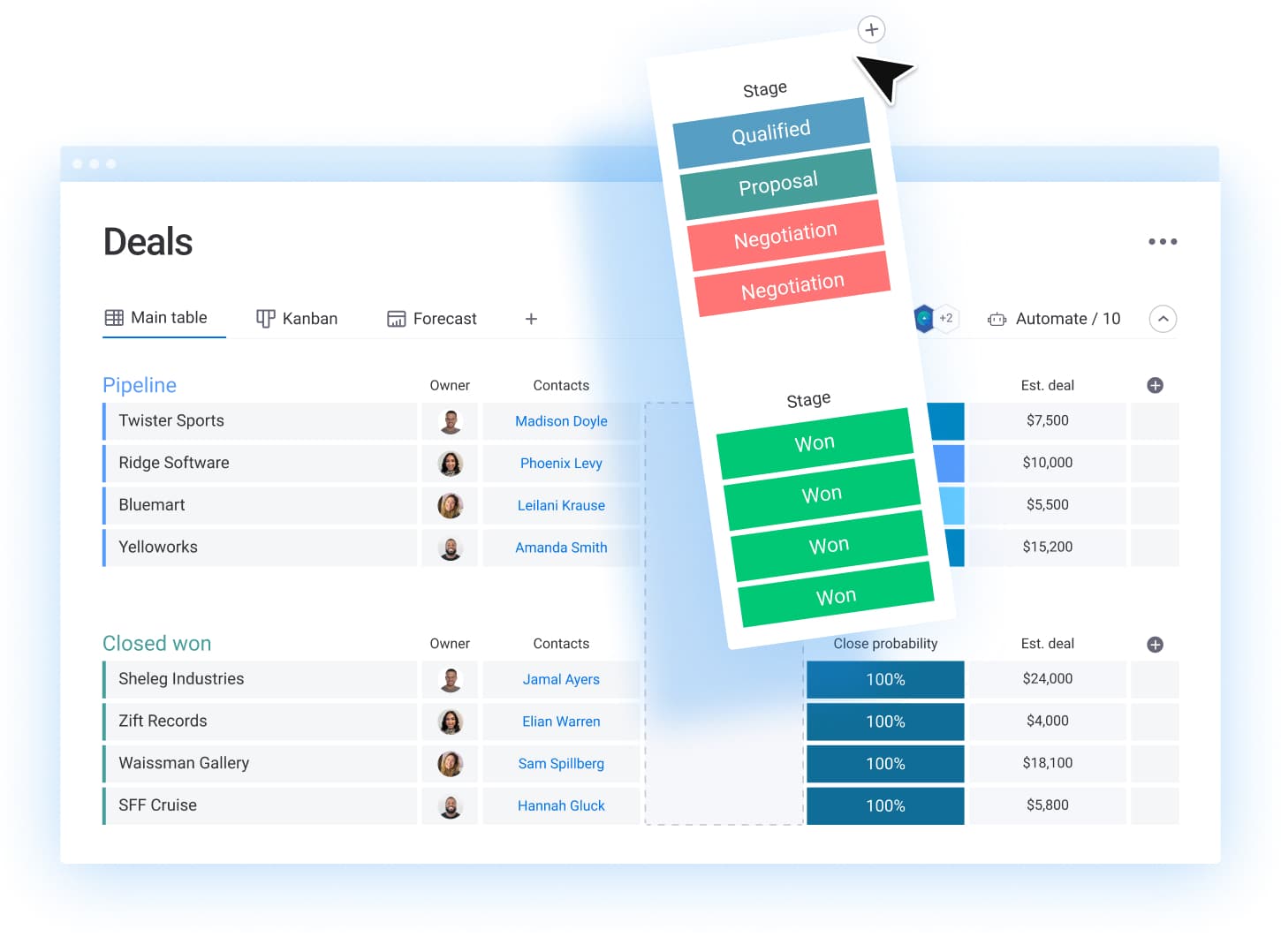
What does an SDR do day-to-day?
What do SDRs actually do all day? Their job boils down to three things: hunting down potential customers, figuring out who’s worth pursuing, and booking meetings that their AEs can turn into deals. SDRs typically manage dozens of prospects simultaneously, switching between research, outreach, and qualification throughout their day.
Their success depends on maintaining organized workflows and consistent follow-up across multiple communication channels.
Prospecting and lead generation
SDRs find prospects in two ways: they either qualify the leads coming in through marketing (inbound) or they go hunting for new opportunities themselves (outbound). Inbound prospecting involves reviewing leads from marketing campaigns, website forms, or content downloads. Outbound prospecting requires more detective work, so SDRs research target companies, identify decision-makers, and find relevant contact information.
Common prospecting activities include:
- LinkedIn research: finding contacts who match ideal customer profiles.
- Company analysis: reviewing websites and news for expansion signals or pain points.
- Trigger monitoring: tracking events like funding rounds or leadership changes.
- Database mining: using sales intelligence platforms to find qualified prospects.
Qualifying inbound and outbound leads
Qualification is where SDRs earn their keep. They act as a strategic filter, ensuring only high-potential opportunities reach your closers by using specific criteria to identify genuine buyers. This process saves everyone time and improves overall sales efficiency.
SDRs typically evaluate prospects using frameworks that assess budget, authority, need, and timeline. They ask discovery questions to understand the prospect’s challenges, decision-making process, and urgency. For example, an SDR might ask about current solutions, team size, or specific pain points to gauge fit. On advanced platforms like monday CRM, SDRs can track qualification criteria directly in their pipeline, ensuring consistent evaluation across all leads.
Booking meetings for account executives
Once qualified, SDRs schedule meetings between prospects and account executives. This handoff requires careful coordination and detailed documentation. SDRs must capture key information from their conversations — pain points, budget indicators, timeline, and stakeholder details — ensuring account executives enter meetings fully prepared.
The best SDRs provide comprehensive handoff notes that include conversation highlights, qualification rationale, and suggested talking points. They coordinate calendars, send meeting invitations, and often join initial calls to make warm introductions.
Managing multi-channel outreach
SDRs engage prospects across multiple touchpoints to maximize response rates. A typical outreach sequence might include an initial email, LinkedIn connection request, follow-up call, and personalized video message spread over several weeks. Each touchpoint builds on previous interactions, creating a cohesive narrative that resonates with prospects.
Multi-channel outreach requires careful orchestration. SDRs must track which messages were sent, when follow-ups are due, and how prospects have engaged. Bloomberg Intelligence reported in 2025 that organizations using multi-channel SDR outreach (combining email, phone, social, and video) achieved a 32% higher meeting-booking rate versus those relying on single-channel outreach.
Modern platforms like monday CRM streamline this process by centralizing all communications and automating follow-up reminders, allowing SDRs to manage more prospects without dropping balls.
SDR vs BDR and account executive: differences explained
Clear role definitions are the backbone of an efficient sales organization. When SDRs, BDRs (Business Development Representatives), and account executives each understand their lane, handoffs become smoother, pipelines stay healthy, and deals move faster.
Although the titles sound similar, these roles serve distinct purposes in the revenue engine: from how they generate pipeline to the metrics they’re responsible for.
The breakdown below clarifies those differences so your team can structure responsibilities, set expectations, and build a scalable path for growth.
| Role | Primary focus | Key activities | Success metrics |
|---|---|---|---|
| SDR | Qualifying inbound leads | Research, qualification calls, meeting scheduling | Qualified opportunities created |
| BDR | Generating outbound opportunities | Cold outreach, account mapping, initial interest generation | New meetings booked |
| Account executive | Closing deals | Demos, negotiations, contract management | Revenue closed |
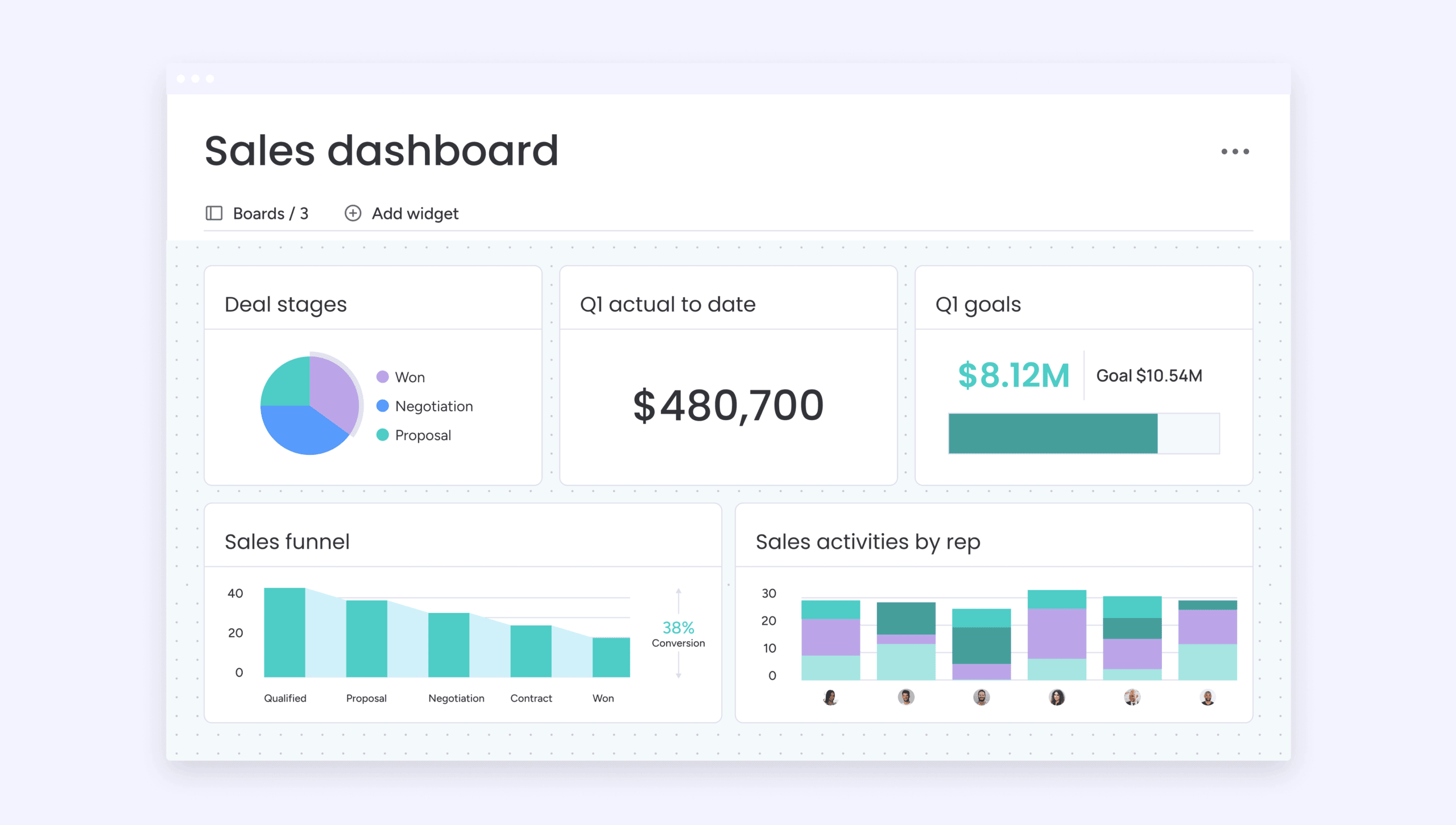
Understanding sales development vs business development
Sales Development Representatives typically focus on inbound leads who have already shown interest. They qualify these warm prospects and determine readiness for sales conversations. BDRs on the other hand generally concentrate on outbound prospecting, reaching out to cold prospects who haven’t yet engaged with the company.
In practice, many organizations blur these lines. Some SDRs handle both inbound and outbound, while others specialize. The distinction often depends on company size, sales volume, and market approach. What matters most is clear role definition within your specific organization.
How SDRs enable account executive success
SDRs directly impact account executive performance by delivering qualified, sales-ready opportunities. When SDRs do their job well, account executives spend less time chasing dead ends and more time advancing real deals. This partnership creates a multiplier effect: better qualification leads to higher close rates, which motivates continued collaboration.
Effective SDR-AE partnerships share several characteristics:
- Clear handoff criteria: both parties understand what constitutes a qualified opportunity.
- Detailed documentation: SDRs provide comprehensive notes about prospect needs and context.
- Regular feedback loops: AEs share outcomes to help SDRs refine qualification.
- Aligned incentives: compensation structures reward quality over quantity.
Where do SDRs fit in your sales structure?
SDRs typically report to sales development managers or sales operations leaders, though some organizations have them report directly to sales leadership. The reporting structure impacts team dynamics, career development, and operational efficiency.
Most successful teams maintain a ratio of two to three SDRs per account executive, ensuring adequate pipeline coverage without overwhelming AEs with meetings.
7 essential skills every SDR needs
Exceptional SDRs are developed, not born. The role demands a crucial mix of interpersonal skills, technological proficiency, and data literacy. These capabilities enable SDRs to effectively navigate rejection, leverage modern technology, and consistently generate qualified opportunities. The most successful SDRs continuously refine these skills through consistent practice, training, and constructive feedback.
1. Multi-channel communication mastery
SDRs must excel at crafting messages across email, phone, social media, and video. Each channel requires different approaches: emails need compelling subject lines and concise value propositions, while phone calls demand conversational skills and quick thinking. The best SDRs adapt their tone and message to each medium while maintaining consistent value messaging.
2. Active listening and discovery
Active listening goes beyond hearing words; it involves understanding context, identifying unstated needs, and asking follow-up questions that uncover deeper insights. SDRs use discovery techniques to understand prospect challenges, current solutions, and decision criteria. Questions like “What prompted you to explore new solutions?” or “How does this challenge impact your team?” reveal qualification signals and pain points.
3. CRM and technology proficiency
Modern SDRs rely heavily on technology to manage their workflows. CRM proficiency includes accurate data entry, pipeline management, activity tracking, and report generation. Beyond basic CRM skills, SDRs must master sales engagement platforms, social selling tools, and communication technologies. With monday CRM, SDRs can automate routine tasks and focus on high-value activities like actual conversations with prospects.
4. Time management and prioritization
SDRs juggle numerous prospects, activities, and deadlines daily. Effective time management means knowing which prospects to prioritize, when to follow up, and how to balance prospecting with administrative tasks. Successful SDRs use techniques like time-blocking for focused prospecting, batch processing similar tasks, and leveraging automation for routine activities.
5. Resilience and adaptability
Rejection is part of the SDR role. High performers maintain positive attitudes despite frequent “no” responses, learning from each interaction to improve their approach. Adaptability means adjusting strategies based on what works, testing new messaging, and staying current with industry trends and buyer preferences.
6. Data analysis and pattern recognition
Modern SDRs use data to refine their strategies. They analyze response rates, conversion metrics, and engagement patterns to identify what resonates with prospects. This analytical approach helps SDRs recognize which industries, titles, or company sizes are most likely to convert, allowing them to focus efforts where they’ll have maximum impact.
7. Social selling and digital engagement
Social selling has become essential for SDR success. This involves building credibility on platforms like LinkedIn, sharing valuable content, and engaging with prospect posts before making direct contact. Effective social sellers position themselves as helpful resources rather than pushy salespeople, warming up cold prospects through consistent, value-added interactions.
Modern SDR tools and technology explained
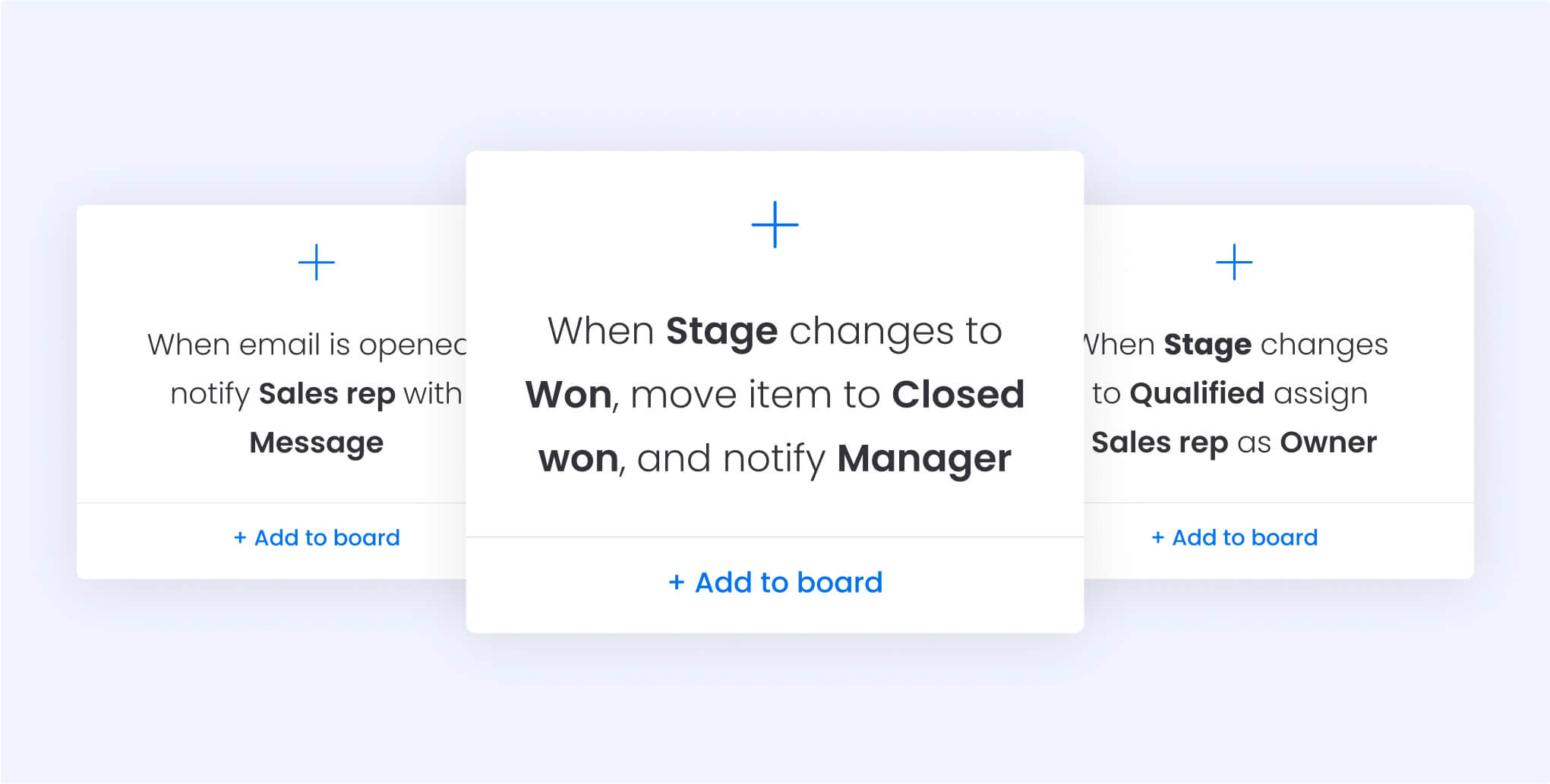
The technology utilized by an SDR significantly determines their overall performance. The strategic deployment of the right tech stack can transform an individual into a prospecting powerhouse.
Effective tools multiply SDR productivity, enabling them to engage more prospects with enhanced personalization. Modern SDR technology stacks integrate prospecting, engagement, and analytics capabilities into cohesive workflows that drive consistent results.
- AI-powered prospecting platforms: these tools analyze buying signals, technographic data, and behavioral patterns to surface and prioritize high-potential leads. They offer features like predictive lead scoring and intent data analysis, saving hours of manual research and improving targeting accuracy.
- CRM systems for SDR productivity: the CRM acts as the SDR’s command hub, centralizing all prospect data, interaction history, and pipeline information. Intelligent platforms (such as monday CRM) offer built-in automation, customizable workflows, and AI-powered insights to enhance efficiency and smarter work.
- Multi-channel engagement tools: specialized platforms for email sequencing, social media, and call automation enable SDRs to design and track multi-touch campaigns. They allow personalization at scale and ensure all cross-channel engagement data is captured and accessible.
- Analytics and performance dashboards: real-time analytics provide instant visibility into individual and team performance. Customizable dashboards (provided by platforms like monday CRM) track key metrics (e.g., activity levels, response rates, pipeline contribution) to help managers identify bottlenecks and optimize strategies quickly.
How is AI revolutionizing SDR teams?
AI is completely changing what it means to be an SDR. Tasks that once took hours of manual grinding now happen automatically, letting SDRs focus on what humans do best.
AI doesn’t replace human SDRs — it amplifies their capabilities, handles routine tasks, and enables unprecedented scale. This evolution is creating new opportunities for both SDRs and the organizations that employ them.
The shift from manual to automated outreach
Traditional SDR work involved hours of manual research, list building, and repetitive outreach. AI automation now handles these time-consuming tasks, freeing SDRs to focus on strategic activities. Automated workflows can trigger personalized emails based on prospect behavior, schedule follow-ups at optimal times, and update CRM records without human intervention.
AI agents for 24/7 lead qualification
AI SDR agents represent the next frontier in sales development. These digital teammates can call prospects, ask qualification questions, and book meetings around the clock. Unlike human SDRs limited by working hours, AI agents ensure every lead receives immediate attention, dramatically improving speed-to-lead metrics.
The most advanced AI agents, like those integrated with monday CRM, learn from every interaction. They refine their qualification logic based on outcomes, adapt their conversation style to different personas, and maintain perfect data hygiene. This creates a feedback loop where the AI becomes more effective over time while providing complete transparency through call recordings and summaries.
Predictive analytics for smarter targeting
AI analyzes vast amounts of data to predict which prospects are most likely to buy. By examining historical patterns, current behaviors, and market signals, predictive analytics help SDRs focus on opportunities with the highest conversion potential. This targeted approach improves efficiency and results while reducing time wasted on poor-fit prospects.
Balancing human touch with AI efficiency
The winning formula? Let AI handle the repetitive grunt work while your human SDRs bring the creativity, intuition, and relationship skills that no algorithm can match. AI handles high-volume, repetitive tasks like initial outreach and basic qualification, while human SDRs manage complex conversations, build relationships, and navigate nuanced situations. This hybrid model delivers the best of both worlds — scale and personalization.
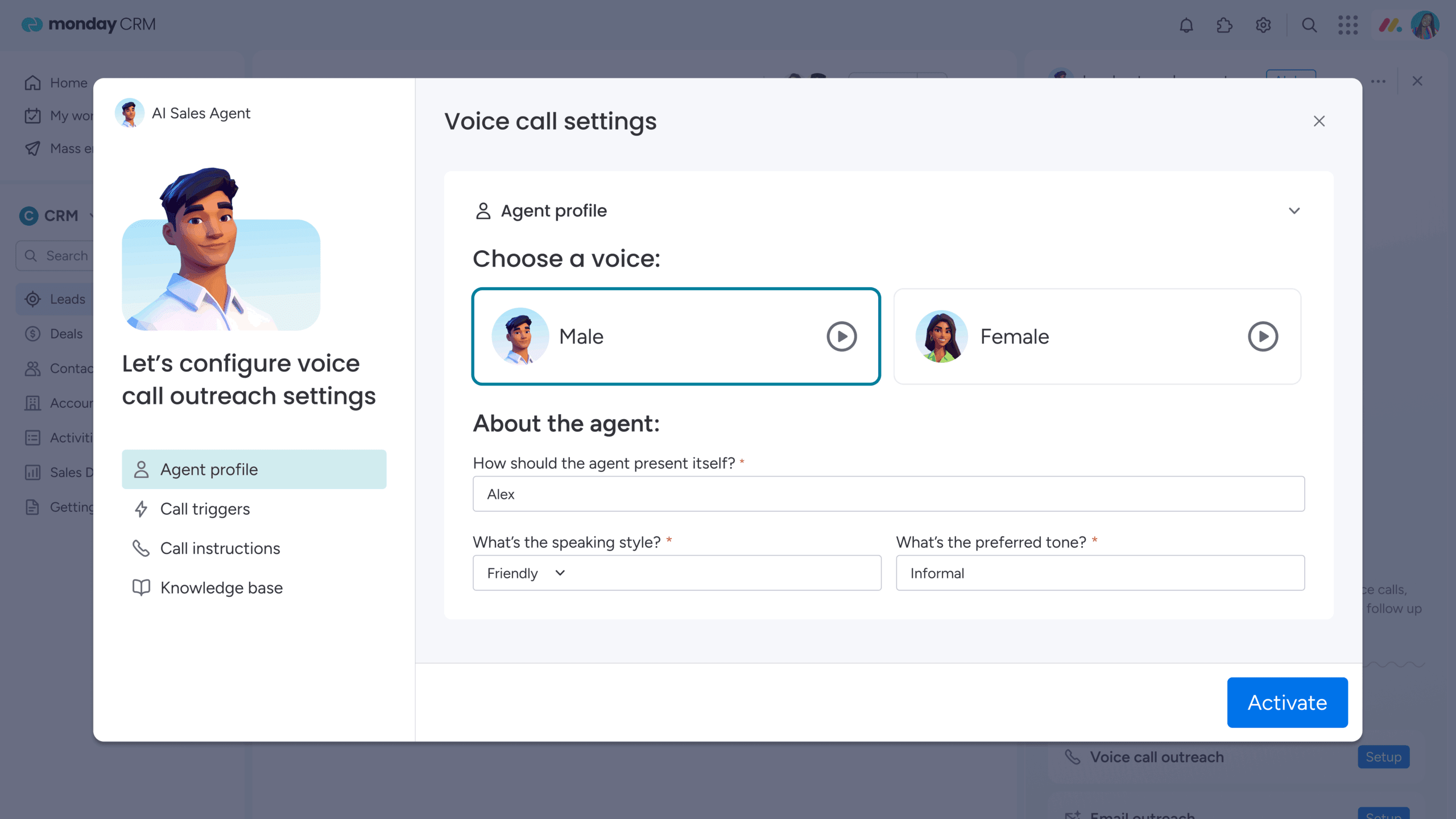
Revolutionize your SDR function with monday CRM
A powerful CRM solves the key challenges SDRs face: keeping track of hundreds of prospects, ensuring consistent follow-ups, and providing a transparent view of pipeline development. Automation, AI capabilities, and intuitive workflows are all combined by monday CRM to help SDR teams scale their impact without scaling headcount.
- AI SDR Agent for 24/7 pipeline growth: the platform’s AI SDR agent operates continuously, calling new leads, qualifying prospects, and booking meetings around the clock. Setup is simple, and the agent learns from CRM data and feedback, maintaining full transparency through recorded calls and automated summaries.
- Automated calling, qualifying, and booking: the AI agent handles the entire early-stage sales process automatically, calling leads within seconds, asking intelligent qualification questions, and scheduling meetings directly. Every interaction is logged automatically for perfect data hygiene.
- Full visibility with real-time dashboards: real-time sales dashboards provide instant insights into SDR performance, pipeline health, and conversion metrics. Sales leaders gain automatic data updates, eliminating manual reporting and enabling confident forecasting.
- Rapid pipeline scaling: unlike complex enterprise systems, monday CRM activates instantly. SDR teams can begin leveraging AI capabilities, automation workflows, and performance tracking immediately, ensuring rapid deployment and faster time-to-value for pipeline generation.
Frequently asked questions
Is being an SDR stressful?
The role can be demanding, especially with high outreach targets and regular rejection. But with the right coaching, clear processes, and tools that automate busywork, it becomes far more manageable. Many reps find it rewarding because they build valuable sales skills quickly — it’s one of the most common launching pads into account executive and sales leadership roles.
What's the difference between inbound and outbound SDRs?
Inbound SDRs qualify leads who have already expressed interest through website forms, content downloads, or marketing campaigns. Outbound SDRs proactively reach out to cold prospects who haven't yet engaged with the company.
How long does it typically take to get promoted from SDR?
Most SDRs get promoted to account executive roles within 12-18 months, depending on performance and available opportunities. Consistent quota attainment and strong qualification skills accelerate advancement.
Can SDRs work remotely effectively?
SDRs can work remotely successfully with proper technology, clear communication protocols, and regular virtual coaching. Many organizations now hire remote SDRs to access wider talent pools.
Which industries have the highest demand for SDRs?
Demand is strongest in industries with complex products and long sales cycles — especially technology, SaaS, financial services, and healthcare. These sectors rely heavily on specialized prospecting and qualification, making SDRs essential for building a predictable pipeline.
How has AI changed the SDR role?
AI has automated routine SDR tasks like data entry, initial outreach, and lead scoring, allowing human SDRs to focus on relationship building, complex qualification, and strategic account development.
 Get started
Get started 

